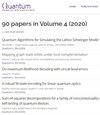$\mathcal{PT}$-三态对称映射及其在云量子处理器上的实现
IF 5.1
2区 物理与天体物理
Q1 PHYSICS, MULTIDISCIPLINARY
引用次数: 0
摘要
$\mathcal{PT}$-对称系统由于其非常规的性质而引起了极大的关注。尽管越来越多的人对此感兴趣,但关于这些系统在实际应用中是否优于厄米系统,以及如果是这样,应该通过什么指标来衡量这种性能,仍然存在争议。我们开发了$\mathcal{PT}$-对称方法来映射$N = 3$纯量子位态来解决这个问题,使用膨胀方法实现了它,并在IBM量子体验的超导量子处理器上进行了演示。我们首次导出了$N = 2$和$N = 3$状态下后选择的$\mathcal{PT}$对称子空间的总体的精确表达式。当应用于$N = 2$纯态的判别时,我们的算法提供了与传统的无二义量子态判别等效的结果。对于$N = 3$状态,我们的方法引入了传统厄米系统中不可用的新功能,能够将任意一组三个纯量子态转换为另一组,但代价是引入不确定的结果。对于三状态QKD协议的攻击,我们的算法具有与传统的最小错误、最大置信度和最大互信息策略相同的错误率。对于后选择量子计量,我们的结果提供了精确的条件,其中$\mathcal{PT}$对称量子传感器在信息成本率方面优于其厄米对偶。结合带标点符号的非结构化量子数据库搜索,我们的方法以增加辅助设备为代价显著降低了量子比特读出需求,同时保持了与原始带标点符号的Grover算法相同的平均oracle调用次数。我们的工作为在量子通信、计算和密码学中应用$\mathcal{PT}$对称性开辟了新的途径。本文章由计算机程序翻译,如有差异,请以英文原文为准。
$\mathcal{PT}$-symmetric mapping of three states and its implementation on a cloud quantum processor
$\mathcal{PT}$-symmetric systems have garnered significant attention due to their unconventional properties. Despite the growing interest, there remains an ongoing debate about whether these systems outperform their Hermitian counterparts in practical applications, and if so, by what metrics this performance should be measured. We developed $\mathcal{PT}$-symmetric approach for mapping $N = 3$ pure qubit states to address this, implemented it using the dilation method, and demonstrated it on a superconducting quantum processor from the IBM Quantum Experience. For the first time, we derived exact expressions for the population of the post-selected $\mathcal{PT}$-symmetric subspace for both $N = 2$ and $N = 3$ states. When applied to the discrimination of $N = 2$ pure states, our algorithm provides an equivalent result to the conventional unambiguous quantum state discrimination. For $N = 3$ states, our approach introduces novel capabilities not available in traditional Hermitian systems, enabling the transformation of an arbitrary set of three pure quantum states into another, at the cost of introducing an inconclusive outcome. Our algorithm has the same error rate for the attack on the three-state QKD protocol as the conventional minimum error, maximum confidence, and maximum mutual information strategies. For post-selected quantum metrology, our results provide precise conditions where $\mathcal{PT}$-symmetric quantum sensors outperform their Hermitian counterparts in terms of information-cost rate. Combined with punctuated unstructured quantum database search, our method significantly reduces the qubit readout requirements at the cost of adding an ancilla, while maintaining the same average number of oracle calls as the original punctuated Grover's algorithm. Our work opens new pathways for applying $\mathcal{PT}$ symmetry in quantum communications, computing, and cryptography.
求助全文
通过发布文献求助,成功后即可免费获取论文全文。
去求助
来源期刊

Quantum
Physics and Astronomy-Physics and Astronomy (miscellaneous)
CiteScore
9.20
自引率
10.90%
发文量
241
审稿时长
16 weeks
期刊介绍:
Quantum is an open-access peer-reviewed journal for quantum science and related fields. Quantum is non-profit and community-run: an effort by researchers and for researchers to make science more open and publishing more transparent and efficient.
 求助内容:
求助内容: 应助结果提醒方式:
应助结果提醒方式:


